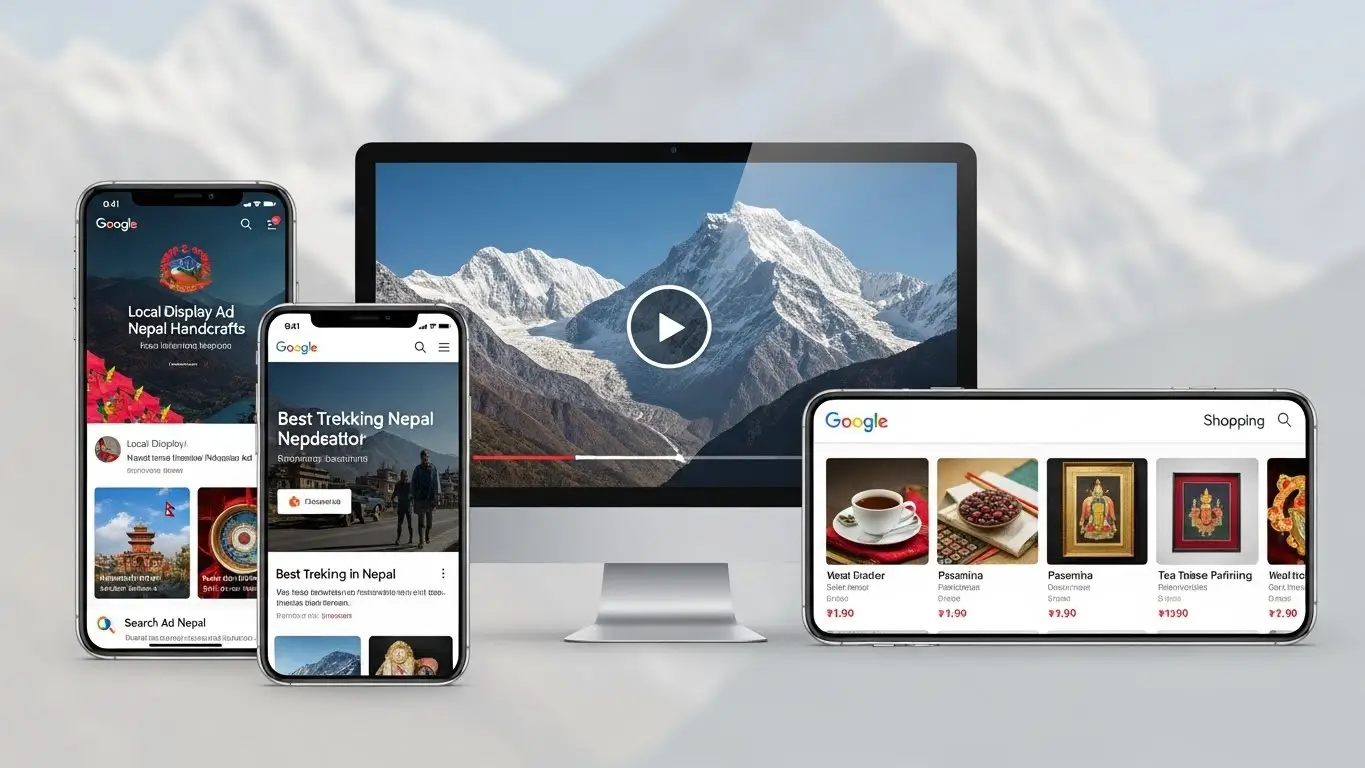Social media marketing has become an indispensable tool for businesses, helping them connect with their audience, build brand awareness, and drive sales. In simple terms, it’s a way for companies to promote their products and services on popular social media platforms, like Facebook, Instagram, Twitter, and LinkedIn.
Let’s delve into the basics, benefits, process of setting and achieving realistic goals, and some eye-opening statistics about social media marketing.
Key Insights
Over 60% of Nepal’s population is now online, making social media platforms like Facebook and Instagram powerful channels for businesses to reach local audiences effectively.
Setting clear, measurable goals such as brand awareness, website traffic, or lead generation is crucial for a focused and successful social media marketing strategy.
Mobile usage dominates social media access in Nepal, with nearly all users browsing on mobile devices, underlining the importance of mobile-friendly content.
Engaging and authentic content, combined with active audience interaction, helps build loyalty and strengthen brand presence in Nepal’s competitive market.
Leveraging data and analytics allows businesses to continually refine their social media efforts, ensuring better targeting and higher returns on marketing investment.
Table of Contents
What is social media marketing?
Social media marketing involves using social media platforms to reach and engage with your target audience. Instead of just posting updates, it allows businesses to create meaningful connections by sharing content that resonates with their followers. This content can include text, images, videos, and more.
Benefits of Social Media Marketing
- Increased Brand Awareness: Social media is a powerful tool for increasing brand visibility. By consistently posting engaging content, businesses can reach a wider audience, making more people aware of their products or services.
- Improved Customer Engagement: Social media platforms provide a direct line of communication between businesses and their customers. Responding to comments and messages and engaging with the audience helps build a loyal customer base.
- Cost-Effective Advertising: Traditional advertising can be expensive, but social media marketing offers cost-effective options. Paid advertising on platforms like Facebook allows businesses to target specific demographics, ensuring their message reaches only the right people.
- Boosted Website Traffic: Social media is an excellent driver of website traffic. By sharing links to your website in posts, businesses can direct followers to their online space, increasing the chances of conversions.
- Enhanced SEO: Social media presence is a factor that search engines consider when ranking websites. Active and popular social media profiles contribute to a positive SEO impact.
- Valuable Market Insights: Social media provides a goldmine of data and insights about your audience. Analyzing engagement metrics, comments, and shares can help businesses understand what works and refine their strategies.
Set Goals that Make Sense for Your Business

Before diving into social media marketing, it’s crucial to set clear and realistic goals. Here are some examples:
- Increase Brand Awareness: If your business is relatively unknown, focus on creating content that introduces your brand to a wider audience and track metrics, like reach and impressions.
- Drive Website Traffic: If your goal is to boost website visits, share links to your site in your posts. Monitor click-through rates and analyze which content drives the most traffic.
- Generate Leads: Use social media to capture leads by promoting exclusive offers, contests, or gated content. Track the number of sign-ups or inquiries generated from your social media efforts.
- Boost Sales: If your primary aim is to increase sales, consider running targeted ad campaigns on social media platforms. Monitor conversion rates and track sales directly attributed to your social media efforts.
- Build Customer Loyalty: Engage with your audience regularly, respond to comments, and create content that fosters a sense of community. Measure customer retention rates and satisfaction levels.
- Monitor competitors: Keep an eye on what your competitors are doing on social media. This can provide insights into industry trends and help you differentiate your brand.
Setting specific, measurable, achievable, relevant, and time-bound (SMART) goals ensures you can track progress and adjust your strategy as needed.
Social Media Marketing Statistics
Understanding the impact and potential of social media marketing is crucial for businesses. Let’s explore some eye-opening statistics:
- Facebook: With over 3 billion monthly active users, Facebook remains the largest social media platform. Businesses can reach a diverse audience through targeted ads and organic content.
- Instagram: Boasting more than 2 billion users, Instagram is popular for its visually appealing content. It’s a powerful platform for businesses in industries like fashion, food, and travel.
- Twitter: Twitter, with its 611 million monthly active users, is a platform for real-time updates. It’s ideal for businesses aiming to stay current and engage in direct conversations with their audience.
- LinkedIn: For B2B businesses, LinkedIn is invaluable. With over 1.2 billion users, it’s a professional networking platform that allows businesses to showcase their expertise.
- TikTok: This platform has exploded in popularity, particularly among younger audiences. With 1.59 billion monthly active users, businesses can leverage TikTok for creative and engaging content.
- YouTube: As the second-largest search engine, YouTube has over 2.5 billion logged-in monthly users. Video content on YouTube can significantly impact brand visibility.
- Pinterest: With a focus on visual discovery, Pinterest has 578 million monthly active users. It’s particularly effective for businesses in niches like home decor, fashion, and DIY.
- Engagement Metrics: Monitoring engagement metrics like likes, shares, comments, and click-through rates is crucial for understanding your audience’s response to your content.
- Mobile Usage: About 99% of social media users access platforms via mobile devices. Ensuring your content is mobile-friendly is essential for reaching a broad audience.
- Influencer Marketing: Collaborating with influencers is a powerful strategy. Statistics show that businesses earn an average of $5.78 for every dollar spent on influencer marketing.
The Essentials of a Successful Social Media Marketing Strategy
- Know Your Audience:
Understand your target audience’s preferences, behaviours, and needs. Tailor your content to resonate with them, making your brand relatable and engaging. - Choose the Right Platforms:
Focus on platforms where your audience is most active. If your audience leans towards visuals, Instagram or Pinterest may be ideal. If it’s about professional connections, LinkedIn is the go-to. - Consistent Branding:
Maintain a consistent brand voice, colours, and imagery across all platforms. Consistency builds recognition and trust among your audience. - Content is King:
Craft content that adds value, educates, entertains, or solves a problem for your audience. Mix it up with images, videos, infographics, and interactive elements to keep things interesting. - Utilize Data and Analytics:
Leverage analytics tools to measure the performance of your social media efforts. Analyze metrics like engagement, reach, and conversion rates to refine your strategy continually. - Engage with Your Audience:
Respond to comments, messages, and mentions promptly. Building a genuine connection with your audience fosters loyalty and positive brand perception. - Incorporate Video Content:
Video content is a powerful tool for storytelling and engagement. Utilize live videos, tutorials, or behind-the-scenes glimpses to capture and maintain audience interest. - Stay Trendy:
Keep an eye on industry trends and popular hashtags. Integrating trending topics into your content helps your brand stay relevant and discoverable. - Social media advertising:
Allocate a budget for targeted social media ads. Paid campaigns can boost visibility, reach specific demographics, and drive conversions effectively. - Monitor competitors:
Keep tabs on your competitors’ social media activities. Analyze what works well for them and adapt successful strategies to your advantage.
A Guide to Create Your Social Media Marketing Plan

- Set Clear Goals:
Clearly define your objectives. Whether it’s brand awareness, lead generation, or customer engagement, having specific goals provides direction. - Identify Key Performance Indicators (KPIs):
Choose relevant metrics to measure the success of your goals. KPIs may include likes, shares, conversions, click-through rates, and follower growth. - Develop a Content Calendar:
Plan your content to maintain consistency. A content calendar helps you stay organized and ensures a diverse mix of posts. - Allocate Resources:
Determine the resources needed for your social media strategy, including human resources, budget, and time. Allocate resources wisely to achieve your goals efficiently. - Monitor and Adapt:
Regularly review your strategy’s performance. If certain tactics aren’t working, be open to adjustments. Flexibility and adaptability are keys to sustained success. - Foster Community Engagement:
Actively engage with your audience. Encourage discussions, host Q&A sessions, and create polls to make your followers feel valued and connected. - Educate and Entertain:
Strive for a balance between informative and entertaining content. Blend educational posts with humour, stories, or interactive elements to keep your audience captivated. - Collaborate and Network:
Collaborate with influencers, other businesses, or industry leaders. Networking enhances your reach and credibility by tapping into new audiences. - Stay Authentic:
Authenticity builds trust. Be genuine in your interactions, admit mistakes when necessary, and showcase the human side of your brand. - Review and Celebrate Milestones:
Regularly assess your progress and celebrate milestones. Acknowledge achievements and learn from challenges to refine your strategy continuously.
Final Thoughts
Social media marketing is now essential for businesses to connect with their audience and boost brand visibility. By knowing your target market, setting clear goals, and sharing engaging content on platforms like Facebook, Instagram, and LinkedIn, you can maximize your reach and impact.
Regularly monitoring your strategy and adapting to trends will ensure your brand stays relevant in Nepal’s fast-evolving digital world.
Creating authentic connections and using data wisely builds customer loyalty and drives real growth. Whether you are a small startup or a well-established company, a smart social media plan is key to standing out and succeeding online.
Contact us today and unlock the full potential of social media marketing to take your business to the next level!
Frequently Asked Questions (FAQs)
What is social media marketing, and how can it help my business in Nepal?
Social media marketing uses platforms like Facebook and Instagram to connect with your audience, build brand awareness, and drive sales locally.
Which social media platforms are best for businesses in Nepal?
Facebook, Instagram, TikTok, LinkedIn, and YouTube are popular and effective platforms for reaching diverse Nepali audiences.
How much does social media marketing cost for businesses in Nepal?
Costs vary by campaign scope, but basic packages start around NPR 10,000 per month with options for paid ads and influencer marketing.
Can small businesses benefit from social media marketing in Nepal?
Yes, social media is a cost-effective and scalable way for small businesses to engage customers and grow their brand.
What types of content work best on social media?
Engaging content such as videos, images, stories, and interactive posts resonates well with users and boosts engagement.
How do I set realistic social media marketing goals?
Set SMART goals focused on brand awareness, website traffic, lead generation, sales, or customer loyalty to guide your strategy.
Why is it important to monitor social media engagement and analytics?
Tracking metrics like likes, shares, and click-through rates helps understand audience response and refine marketing tactics.
What role does mobile usage play in social media marketing?
With over 99% of users accessing platforms via mobile, mobile-friendly content is crucial for maximum reach and engagement.
How can influencer marketing boost my social media efforts?
Collaborating with local influencers helps amplify your message and build trust with targeted customer groups in Nepal.
What common mistakes should businesses avoid in social media marketing?
Avoid inconsistent posting, ignoring audience interaction, neglecting analytics, and failing to tailor content for different platforms.



